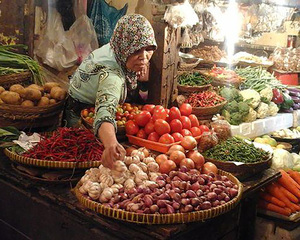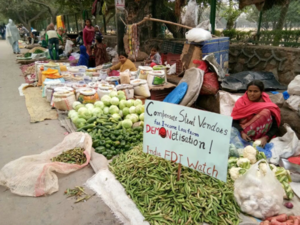Supermarket watch Asia bulletin, Issue 5, February 2017
Editorial: "Cashless" economy is a blow to small producers
Fresh markets sustain the economies and livelihoods of millions of people. Despite this reality, the governments of many Asian countries are systematically adopting policies that undermine local markets and the people who rely on them. From Hong Kong to Hanoi, governments are banning fresh markets or scaling back market interventions that once kept corporations and price volatility in check. In Indonesia, for instance, the government lifted commodity price regulations, eroding the food security of farmers, small traders and poor consumers.
One of the most extreme recent examples is the demonetisation process that occurred in India. In a reckless effort supposedly aimed at tackling corruption and the black market, India’s prime minister pulled 86 per cent of the country’s currency out of circulation overnight, creating severe distress throughout the country. The decision to turn India into a “cashless” society, to be replaced by digital banking and plastic transactions, has taken much of rural society by surprise. In rural India, the digital infrastructure necessary to facilitate such a transition is almost nonexistent.
Rather than addressing corruption and the shadow economy, small-scale producers, farmers and street hawkers who do not have access to the digital banking system are the hardest hit by this decision. The Indian demonetisation initiative caused a sudden breakdown in all facets of the trade and commercial system, but cash-centric sectors like agriculture and the large informal market were hit particularly hard, with many livelihoods completely devastated. More than 95 per cent of all transactions in India were conducted in cash and 90 per cent of vendors didn’t have the means to accept anything besides cash. On top of this, 85 per cent of workers were paid exclusively in cash and almost half of the population didn’t even have bank accounts (Forbes, January 2017).
In a letter to the Indian prime minister, farmers stressed that demonetisation was being used to forcibly integrate the rural and urban poor into certain techno-financial regimes—while assuring profits for the corporate sectors that run them. The decision to move to digital money is shifting people from traditional markets to superstores and helping e-commerce gain momentum. Two months after demonetisation, retail outlets are racing to expand to digital payment with 33,000 retail outlets now allowing the use of digital payments. This has led to the increase of credit card transactions by 9.5 per cent. Meanwhile, street vendors’ sales have collapsed as people run out of cash.
As the demonetisation process unfolds, it is turning into more of an effort to “modernise” India’s economy than a fight against crime. This decision—made without taking the country’s massive working class, the urban poor, subsistence farmers and informal traders into account—could put millions of people in jeopardy if there is no arrangement to ensure adequate cash flows for the subsistence economy.
ACROSS THE REGION
Impacts of India’s demonetisation on informal workers
On the night of 8 November, in a surprise TV address to the nation, the Indian Prime Minister announced that 86 per cent of the country’s currency would cease to be legal tender after midnight. High denomination notes of 500 and 1000 were rendered null and void. New notes in denominations of 500 and 2,000 were added.
This demonetisation was supposedly aimed at uprooting corruption, black money and terrorism. The move was generally welcomed and considered bold. Most vouched for its long term benefits. But with just 14 per cent of the currency in circulation, the economy came to a standstill. The replacement by new notes of 2,000 and 500 took months. The slow and painful process of replacement added to the misery. Peoples’ suffering mounted, with catastrophic impacts on their lives. Hundreds of demonetisation related deaths were reported.
Informal workers, constituting 93 per cent of the total Indian workforce, were among the worst affected. Thousands of workers were laid off. Construction activities slowed down. Autos, taxis, cycle rickshaws, domestic workers, loaders and other service workers faced difficulties. Daily wage workers who needed cash on a daily basis to meet their immediate needs did not get any work, which resulted in a reverse migration from cities to villages.
The demonetisation move had an uneven impact on the retail sector. While street vendors were hit hard as they almost completely depend on cash, the superstores and e-retailers reportedly benefited from the shift to cashless transactions. Street vendors’ sales crashed as people ran out of cash. Street vendors and small shops suddenly had no buyers. Even if some people had good luck and got the new 2,000 note, they could not buy from street vendors as they hardly had small denomination notes to pay back the balance. In absence of the new 500 note, which came much later in the market, the new 2,000 note was not of much use.
On the other hand, the government changed its narrative and started working for the cashless economy. The push by the government to a cashless economy boosted the use of plastic money. The use of digital payment methods increased the footfall and sales at superstores. One superstore allowed consumers to withdraw up to 2,000 using their debit cards. Digital wallets gained momentum and are creating the necessary infrastructure to shift people from traditional markets to superstores and e-commerce.
The credit industry is likely to entrap people and fuel consumerism with the rising use of plastic money. Indian mobile wallet leader paytm backed by Chinese e-commerce giant Alibaba already has 20 million users in India and is set to gain from the government move of demonetisation and policy push for cashless transactions.
The likes of paytm and Alibaba aim to change the way Indians buy. Amazon and Flipkart, leaders of e-commerce in India are investing to raise their sales. With the launch of their own digital wallets and credit facilities they look well-positioned to outcompete street vendors and small independent retailers. The informal economy and workers are likely to face even more hardship in the days and weeks to come.
Article by Dharmendra Kumar, FDI Watch
Email: [email protected]
Chilli price and market sovereignty
In early 2017, the price of chilli surged once again in Indonesia, repeating a situation that occurred last year and might well happen again in coming years. Other food commodities face the same situation. A number of arguments arise to explain the price fluctuations, such as blaming climate change, harvest failures or pests and diseases.
During a talk in Imogiri market, a woman seller asked: “nyuwun pirso, sik nemtoke regi meniko sinten Mas? Regi kok asring gantos-gantos, kados kedelai, lombok, lan sanesipun,… soale kulo bodho mboten ngertos, mboten saget tandur, namung nampi regi saking bakul sanes, mesa’ake tiyang alit, nek kulo sade regi inggil”. (Who decides on the price? Why is the price of soy, chilli and other products always changing so rapidly. I’m a fool, I don’t know anything, I can’t grow my own produce, I can only receive from others. I feel sad for the poor when I have to sell my produce at a high price).
This question recalls an era when the “state” played an important role in determining food commodity prices; when buffer-stock institutions influenced food distribution channels while controlling prices; and when the price of staple commodities were part of a strategic framework to anticipate certain conditions and create economic stability. At the same time, distribution channels like markets and other institutions were set up to ensure that economic systems functioned fairly, especially for micro and small enterprise.
Although history also shows that strong state control over the economy in the past was implemented with an iron fist without effective control from the people. State control was not meant to achieve wellbeing for the people, but rather for narrow political interests (oligarchy). Elite political-economic actors were taking advantage of various institutions (political party, bureaucracy, legislative, etc) to secure their power and dominate the supply chain of food and distribution in the markets.
Now, after almost two decades of reforms, the situation has changed enormously but the people’s bargaining position is even worse. Commodity prices are no longer regulated, but rather determine by supply and demand. State intervention is almost nonexistent and everything has been handed over to the market. The negative investment list - a set of limits on foreign investment in particular sector - that was once used to protect the people’s economy has disappeared as well.
The result is the increasing control of market power in the hands of the few (oligopoly). The investment from millions of hardworking small farmers is not valued. In the last few decades the revenue of small traders has continued declining. “Globalisation”, promoted by elite policymakers in the name of democracy, has removed the government from its obligation to the people. Hence, it is understandable that many government elites often “wander” around fresh markets or poor areas, only to create the appearance of concern, but without any strategic power to change the situation.
Perhaps what Mubyarto, one of Indonesia’s leading people’s economy experts, said is true: “People of the same trade seldom meet together, even for merriment and diversion, but the conversation ends in a conspiracy against the public, or in some contrivance to raise prices”.
People’s economy activist and founder of “Sekolah Pasar Rakyat”
Email: [email protected]


